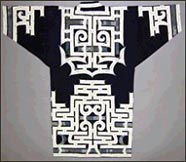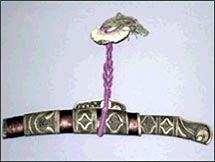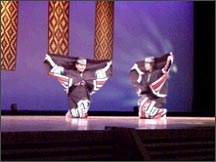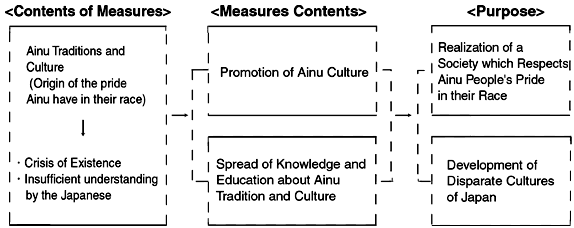Hokkaido Bureau
Promotion of Ainu Culture

Ruumpe (cotton clothing) Property of the Ainu Culture Promotion Foundation

Makiri (knife) Property of the Ainu Culture Promotion Foundation

Sarorunchikappurimuse (the Crane Dance) Shiraoi Folk Performing Arts Preservation Society
The Ainu, though small in number, are a race that is considered to have inhabited Hokkaido together with Wajin ("The people of Wa" or Japanese) in the period following the end of the Medieval Period. The Ainu had their own unique traditions and culture, including language. However, following the rule of the Matsumae Han (feudal fief, or clan) and the so-called assimilation policy for the modernization of Japan conducted during the Meiji Period these traditions and culture that were a source of pride to the Ainu people received a decisive blow making it difficult to say that they are being preserved and transmitted today.
Because of this, in July 1997, the Ainu Culture Promotion and Dissemination of Information Concerning Ainu Traditions Act was enacted to promote a policy for the realization of a society where the Ainu people's racial pride in their culture is respected. Based on this law, in November of the same year the Ainu Culture Promotion / Research Foundation (Ainu Culture Promotion Foundation) was made a designated corporation to engage in various projects as a comprehensive national project.
This foundation undertakes various projects to promote Ainu culture, including the language, Ainu traditions and the spreading of information about the culture.
The Ministry of Land, Infrastructure and Transport and the Ministry of Education, Culture, Sports, Science and Technology subsidize about half of these projects by taking charge of measures related to the promotion of research (Hokkaido assisting with the remainder).
In 2005 a basic plan for the restoration of traditional Ainu living habitats (Ioru) was drawn up. From this point on, the actual materialization will be undertaken by the united effort of the Ministry of Land, Infrastructure and Transport, the Ministry of Education, Culture, Sports, Science and Technology, Hokkaido, and Ainu-related organizations.
Because of this, in July 1997, the Ainu Culture Promotion and Dissemination of Information Concerning Ainu Traditions Act was enacted to promote a policy for the realization of a society where the Ainu people's racial pride in their culture is respected. Based on this law, in November of the same year the Ainu Culture Promotion / Research Foundation (Ainu Culture Promotion Foundation) was made a designated corporation to engage in various projects as a comprehensive national project.
This foundation undertakes various projects to promote Ainu culture, including the language, Ainu traditions and the spreading of information about the culture.
The Ministry of Land, Infrastructure and Transport and the Ministry of Education, Culture, Sports, Science and Technology subsidize about half of these projects by taking charge of measures related to the promotion of research (Hokkaido assisting with the remainder).
In 2005 a basic plan for the restoration of traditional Ainu living habitats (Ioru) was drawn up. From this point on, the actual materialization will be undertaken by the united effort of the Ministry of Land, Infrastructure and Transport, the Ministry of Education, Culture, Sports, Science and Technology, Hokkaido, and Ainu-related organizations.
Promotion of measures related to improvement of Hokkaido Ainu living environment
According to the Hokkaido Utari Survey of Actual Living Conditions conducted in 1999, 23,767 Ainu now live within the jurisdiction of the sub-prefectural Hidaka and Iburi offices.
The first survey, taken in 1972, revealed a large gap between the living environment and children's education of Ainu and other people living in the area. Since 1974, Hokkaido has conducted Hokkaido Utari Welfare Measures (ending in 2001) to improve the Ainu people's social and economic situation in Utari. At present Hokkaido is promoting fundamental measures aimed at (1) secure life, (2) solid education, (3) stable employment, and (4) industrial growth, under a program called, A Promotion Policy for the Improvement of Ainu Life (2002-2008).
To support these measures, the Hokkaido government has created the Hokkaido Ainu Life Improvement Measures Related Ministries Liaison Conference, constituted from seven ministries, aimed at close cooperation of government offices and related governmental agencies. The office of the Ministry of Land, Infrastructure and Transport is striving for comprehensive promotion of measures such as securing Ainu life, stable employment, solid education, improvement of living environment and promotion of industry as a window of this liaison conference.
(In the Ainu language, the word for man is "Ainu," and the word for brethren is "Utari.")
To support these measures, the Hokkaido government has created the Hokkaido Ainu Life Improvement Measures Related Ministries Liaison Conference, constituted from seven ministries, aimed at close cooperation of government offices and related governmental agencies. The office of the Ministry of Land, Infrastructure and Transport is striving for comprehensive promotion of measures such as securing Ainu life, stable employment, solid education, improvement of living environment and promotion of industry as a window of this liaison conference.
(In the Ainu language, the word for man is "Ainu," and the word for brethren is "Utari.")
| |
The Ainu Language: Although the language system is uncertain, it is undisputed that Japanese and Ainu are of different origin. The Ainu language has no writing system, so when it is written, Japanese kana or the Roman alphabet is used. Today there are very few people who can speak the Ainu language freely. | ||||||||
| |
Ainu Culture: The Ainu culture is closely related to traditional Ainu lifestyle and peculiar to the natural environment, such as paths along rivers, and lead to hunting, gathering and fishing as the chief occupations. Examples of Ainu culture:
|
Outline of the Ainu Culture Promotion Act
No. 1 The Gist (Significance) of the Legislation
No. 2 Outline of this Act
| 1. | Definition of Ainu Culture Ainu culture means the Ainu language, music, dance, crafts, and other cultural artifacts inherited by the Ainu people, and cultural artifacts which developed from these. |
||||
| 2. | Responsibilities of the nation and municipal authorities | ||||
|
|||||
| 3. | Things to be considered respecting these measures In implementing measures aimed at the promotion of Ainu culture, the nation and municipal authorities should take into consideration the intentions of the Ainu people themselves and respect their pride in their race. |
||||
| 4. | Basic policies The Minister of Land, Infrastructure and Transport and the Minister of Education, Culture, Sports, Science and Technology should define the statement of principles of the measures for the purpose of promoting Ainu culture. |
||||
| 5. | Master plan Prefectures are appointed by government ordinance, in accordance with basic policy, to establish a basic plan for measures to be taken to promote Ainu culture. (In Article 6, Clause 1, Hokkaido is designated by the "Ordinance Ordering the Formation of Prefectures" in the "Act for Spreading and Educating Knowledge about Ainu Culture Promotion and Ainu Traditions") |
||||
| 6. | Designated corporations The Minister of Land, Infrastructure and Transport and the Minister of Education, Culture, Sports, Science and Technology Education may restrict and designate a Civil Code corporation to perform unified operations to promote Ainu culture throughout the nation. |
||||
| 7. | Supplementary provisions Abolishment of the old "Hokkaido Aborigines Protection Law" and the old "Asahikawa City Aborigines Preserved Land Disposal Law." |
Contents of main enterprises currently undertaken by the Ainu Culture Promotion Foundation
| (1) | Promotion of a comprehensive practical survey of the Ainu people The Ainu Culture Promotion Foundation grants funds for research and publication about Ainu society and culture for the purpose of training and supporting researchers. |
| (2) | Promotion of the Ainu Language The Ainu Culture Promotion Foundation trains Ainu language instructors (leaders) to make up for the current shortage, and develops full-fledged classes both inside and outside Hokkaido. Also, the Ainu Culture Foundation promotes broadcasts of lectures on the Ainu language for beginners twice a week which are re-broadcast on STV (Sapporo Television Broadcasting) radio. |
| (3) | Promotion of Ainu Culture In museums and art galleries throughout Japan collections of ethnic clothing and tools used in everyday life are exhibited to develop interest among Ainu people of their own inheritance, and folk craft exhibits are held to introduce Ainu culture. Also this foundation holds an Ainu Cultural Festival introducing Ainu culture comprehensively through Ainu traditional dance and oral literature (Yukara). |
| (4) | Spreading education about Ainu tradition and culture The Ainu Culture Promotion Foundation holds lecture meetings for the public on Ainu tradition and culture throughout Japan. This foundation manages the Ainu Cultural Exchange Center which primarily offers information about Ainu for metropolitan areas while providing a place for presenting cultural activities of Ainu people residing in Japan. |
